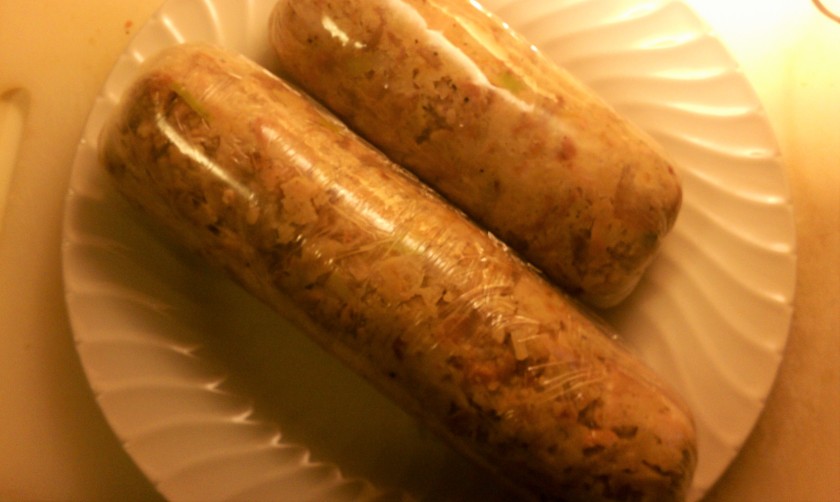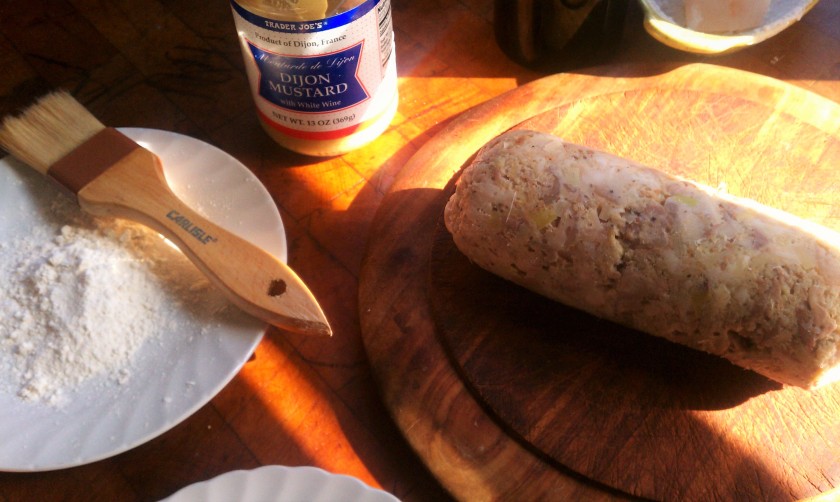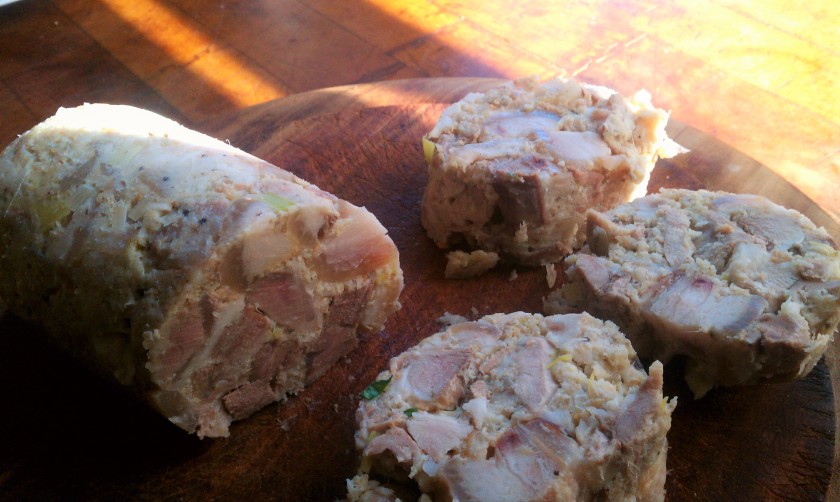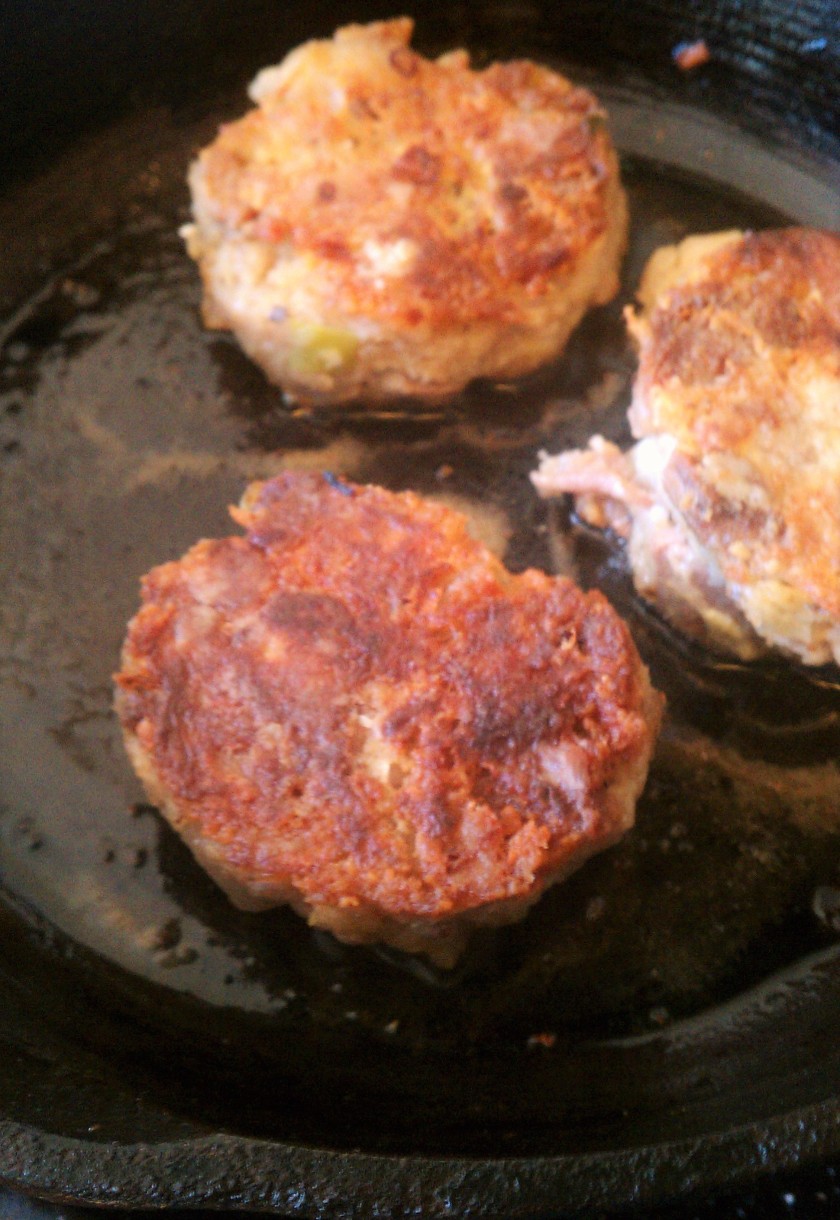Our friend farmer Patti Popp of Sport Hill Farm asked how we cook pork hocks. Patti raises pigs and sells excellent pork.

We got this pork hock from Sport Hill Farm. Pork hocks like to be cooked in moist heat. So first, I put the hock in a pot of cold water and brought it to a boil. Then I removed the hock, rinsed it, dumped out the water and rinsed out the pot. Then I put the hock back in the clean pot, added cold water, a bay leaf, a couple peppercorns, and some salt. After it simmered for about three hours, and the meat was tender, I removed the hock, cut everything off the bones — meat, skin and the white blubbery-looing stuff — and chopped it up. This has to be done while the meat is still warm. Note: Don’t throw out the cooking liquid. You’ll need some for the hocks and you can cook a delicious green pea or bean soup in the broth.

Everything but the bones is used, including the skin.
Then, I added a tablespoon of Dijon mustard, salt and pepper, a sautéed leek (or onion), breadcrumbs and about a half cup of the gelantinous cooking liquid.

Next, the mixture is turned into logs, about two-and-half to three-inch in diameter. I asked my husband to do this part. He piled half of the meat mixture onto plastic wrap, pulled the plastic over it, and rolled it on the cutting board, while holding the ends of the plastic. This is the most difficult part of the process. But you’ll get the hang of it. A straight edge or ruler helps push the meat mixture into the log shape.

The mixture is rolled into logs and then refrigerated overnight.
The logs will keep in the fridge for a couple days, or can be frozen. Remember, they’re already cooked. Before serving, they are sliced and pan fried to create a crisp crust and to warm them through.

When you’re ready to make dinner, unwrap the plastic from the pork. Prepare a plate of flour or panko crumbs.

I sliced the log into one-inch thick pieces. A serrated knife works well for slicing the logs. If any bits fall off, gently press them back into the cake.

Brush each side with mustard and coat in flour or panko bread crumbs.

Heat your cast-iron skillet, and add a tablespoon of olive oil or oil of your choice. Cook over medium-low heat until a nice golden brown crust forms (about five minutes). Turn and cook the other side. Remember not to crowd them (they’ll stick to one another), and don’t fuss with them.

These cakes are crisp on the outside, with an appealing chewiness and meaty flavor. They are rich, so pair them with a salad dressed in an apple cider vinaigrette. If you want to make this dish even more awesome, pair the cakes with sauce gribiche.
Will kids eat this? Yes! We once served this to our nieces and nephew who were all under the age of ten, and they wanted more. I stood at the stove, frying up more and more of them.
My husband and I have been making this recipe for years, and we thought we’d got it from Michel Richard’s “Happy in the Kitchen,” one of my favorite cookbooks. But looking at the book recently, we aren’t sure. He does have a recipe for pigs feet, treated in the same way, and he goes an extra step by wrapping the meat mixture in spring roll wrappers before frying. He also has good tips on how to roll the mixture into a log. If you use pigs feet or shanks, your pork cakes will be more gelantinous, and that’s a good thing. But using the big hock from the back leg that we got a Sport Hill Farm is a far easier enterprise than dealing with the smaller bones and tendons of the smaller cuts.
But ultimately, this is an easy dish, adaptable and forgiving. And very, very good.
If you’re in the Fairfield County region, you can get a pork hock at Sport Hill Farm.
